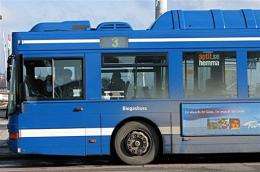City buses turn to sewage for 'clean' fuel

Can the key to "clean" energy be found down in the sewer? That's the idea in Oslo, where city officials soon plan to introduce buses that run on biofuels extracted from human waste.
As of 2010, the new buses are due to start plying the streets of the Norwegian capital.
"It's a win-win situation: It's carbon neutral, it hardly pollutes the environment, it's less noisy and its endlessly renewable," says Ole Jakob Johansen, one of the people in charge of the project at Oslo city hall.
The biofuel, which is methane generated by fermenting sludge, will come from the Bekkelaget sewage treatment plant which handles waste from 250,000 city dwellers.
"By going to the bathroom, a person produces the equivalent of eight litres (2.1 gallons) of diesel per year. That may not seem like a lot, but multiplied by 250,000 people, that is enough to operate 80 buses for 100,000 kilometres (62,000 miles) each," Johansen says.
Compared to diesel, biomethane is a giant green step forward.
In addition to being carbon neutral, it emits 78 percent less nitrogen oxide and 98 percent fewer fine particles -- two causes of respiratory illnesses -- and is 92 percent less noisy.
Even the price is advantageous, says Johansen.
All included, the cost of producing biofuel equivalent to one litre of diesel comes to 0.72 euros (98 cents), while diesel at the pump in Norway currently costs more than 1.0 euro.
"The fuel is less expensive but the cost of the new buses and their maintenance is higher. In total, it's about 15 percent more expensive," notes Anne-Merete Andersen of Ruter, the operator of Oslo's public transport system.
Contrary to first generation bio-ethanol, made from grains and plants, biomethane has the added advantage of not impacting food supplies, nor does it require fertilisation or deplete precious water resources.
Environmentalists are delighted.
"We've been waiting for this for a long time. It's extremely good for the climate and also for the quality of urban life," beams Olaf Brastad of the Bellona environmental organisation.
"I see absolutely no downsides. On the contrary, it is an optimal way of using a renewable energy that has always been there, just waiting to be exploited," he adds.
The initiative, if extended to Oslo's second waste treatment plant and complemented with biofuels made from food waste, could provide enough fuel for all of Oslo's 350 to 400 buses.
"If our entire fleet switched to biomethane, carbon dioxide emissions would be reduced by around 30,000 tonnes per year," according to Ruter.
Biofuel buses have already been introduced in several cities, including the French city of Lille and Stockholm, Sweden, where 70 such buses are already in service.
"There were some teething problems with the introduction, but now that those problems have been resolved we see that we have a fuel that works well," Sara Anderson, a biofuels specialist for Stockholm's public transport system SL, told AFP.
And, for those who remain sceptical, Johansen stressed that "there is absolutely no smell."
(c) 2009 AFP

















